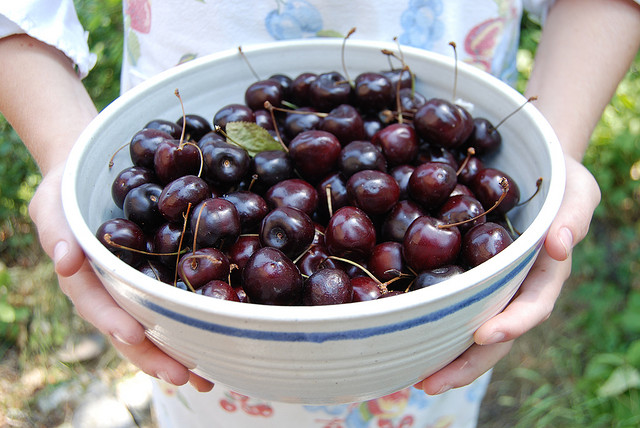The sweltering, hot days of summer are upon us—and what better way to beat the heat than with nature’s bounty? Cherries!
I think of cherries as half berry and half fruit—the last berry of the spring, and the first fruit of the summer. While they look like a small fruit, they deliver all the lymph-moving and fatty-tissue-cleansing properties that berries do.
Unlike many fruits that are on grocery store stands year round, the growing season for cherries lasts only about four months—from late spring through early summer—so get them while you can!
Summer’s seasonal harvest naturally provides a high-carb, low-fat diet (including lots of fresh fruits and vegetables that have been cooked by the sun on the vine) to keep us energized for long, hot days in the sun.
According to Ayurveda, cherries—along with other cooling, cleansing summer foods like apples, pomegranates, and watermelons—help to activate heat-removing channels in the body, such as looser stools and more frequent urination.
While sweet cherries possess many health benefits, some of the best lymph-moving support comes from tart cherries. Tart cherries can be harder to find than the ever-popular sweet cherries, but look for them at your local farmer’s market or in the frozen foods section of your natural foods grocery store—they are often sold frozen, as they are popular for baking.
You can also get a tart cherry concentrate and make a great summer drink when mixed with water.
Due to their high phenolic and anthocyanin content, tart cherries have been found to support the following:
>> The health of joints, muscles, the cardiovascular system, lymphatic movement, weight, and blood sugar balance.
>> The superior antioxidant qualities of tart cherries have been found to help increase our antioxidant defenses and protect us against the damaging effects of oxidative stress.
>> Enhance our exercise—tart cherries have been found to support quicker recovery times and better strength during and after exercise.
>> Help relieve muscle and joint discomfort, without side effects from inflammation associated with regular exercise.
>> Boost natural melatonin production, which can help in enhancing how long and how well we sleep.
Cherries have been found to be particularly high sources of melatonin, which makes them not only a great agent for improved sleep, but also a powerful seasonal tool in your circadian clock repair kit. (Learn more about melatonin and the circadian clock here.)
Since melatonin is one of the oldest molecules on the planet, and every life form is dependent on the light/dark cycles, it’s not surprising that it is found in almost every plant. Some plants actually have quite a bit of melatonin and can be used very successfully—instead of resorting to a supplement.
In a study at M.I.T., researchers discovered that tart cherry juice was an effective sleep tonic. In a previous study, while measuring the effects of tart cherry juice for its anti-inflammatory benefits as a sports recovery drink, some of the subjects reported better sleep. Further studies revealed that the tart cherries were quite high in botanical melatonin!
One study measured two groups of older men. One group received tart cherries, and the other group received a placebo. The tart-cherry-juice group fell asleep faster and woke up less during the night compared to the placebo group.
To follow up that study, researchers measured melatonin levels after drinking the Montmorency tart cherry juice and, once again, saw improvements in sleep time, quality and efficiency that were very likely due to a boost in melatonin levels.
Since this study was published, tart cherries have become quite famous for boosting melatonin and sleep quality, but there are many additional foods to consider to amp up your melatonin levels naturally.
Enjoy summer’s bounty of tart cherries—delicious, naturally cooling, and packed with health benefits. However, as their growing season is coming to an end, get ‘em while it’s hot!
~
For more on seasonal eating:
~
Relephant:
The Natural, Botanical Sleep Inducer for a Good Night’s Rest.
~
Author: Dr. John Douillard
Image: Flickr/julie
Editor: Yoli Ramazzina
Copy editor: Travis May
Social editor: Lieselle Davidson













Read 0 comments and reply